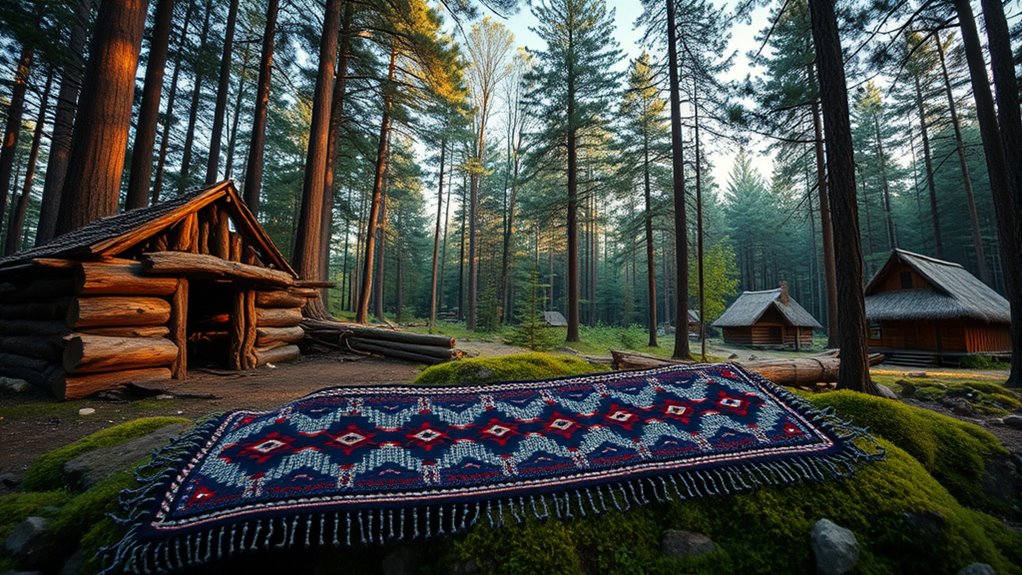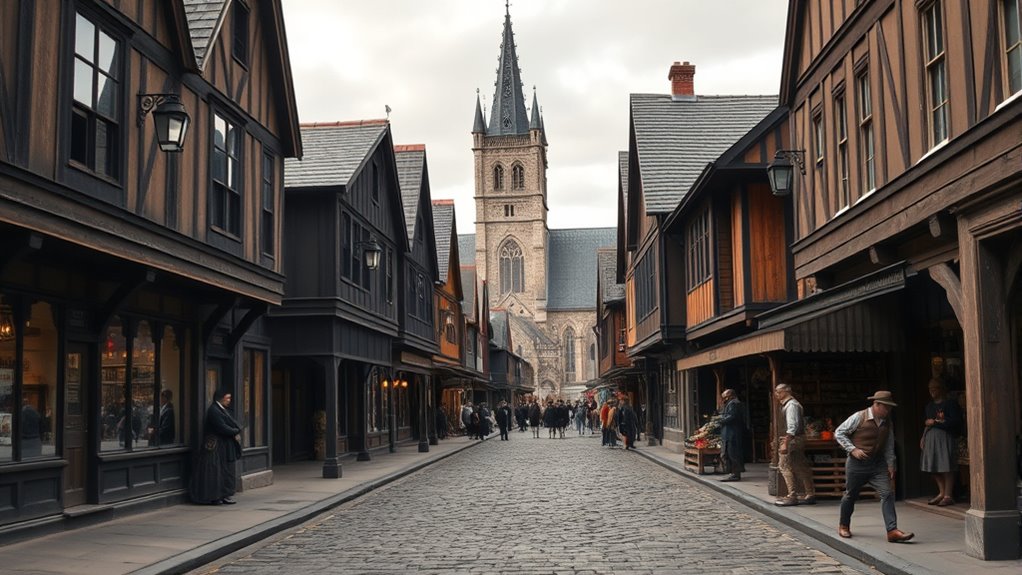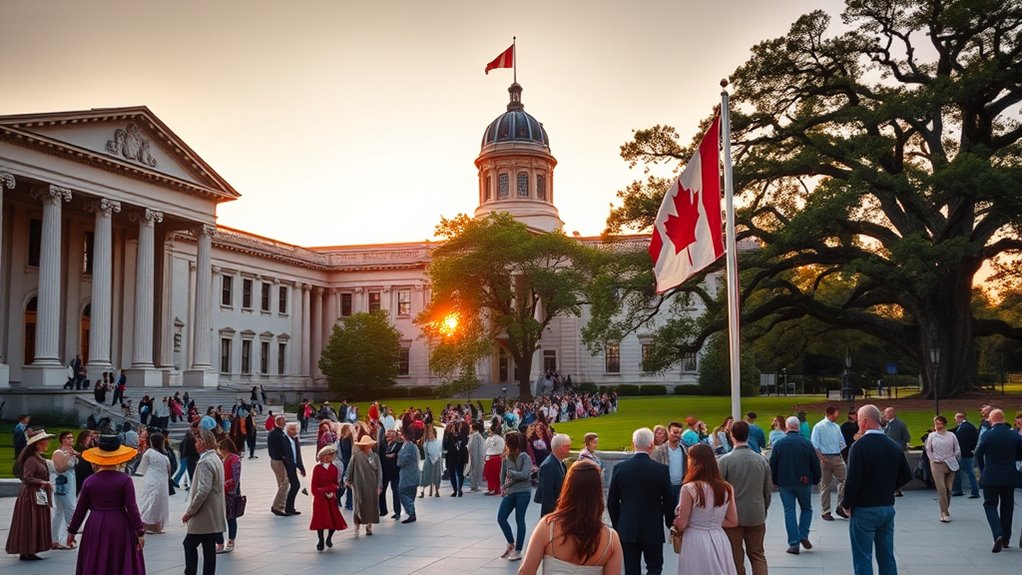Ontario’s history and culture are shaped by Indigenous communities who thrived for thousands of years, creating rich traditions and resilient societies. European influences, especially French and British, introduced language, religion, and Trade, laying a foundation for modern development. Over time, Loyalists, immigrants, and diverse groups built communities, forming a vibrant social fabric. Today, Ontario celebrates its heritage through festivals, preservation efforts, and a mix of urban growth and environmental initiatives—if you want to explore how these elements come together, continue on.
Key Takeaways
- Ontario’s history is shaped by Indigenous cultures, French explorers, and British Loyalist settlements, creating a diverse cultural foundation.
- Indigenous communities maintain traditions, art, and ceremonies that connect generations to the land and reflect resilience.
- French influence introduced language, religion, and land use patterns, persisting despite British control.
- Loyalist immigrants established early communities, blending British customs with local resources, shaping Ontario’s social fabric.
- Modern Ontario features vibrant urban centers, multicultural festivals, and initiatives to preserve its rich historical and cultural heritage.
Early European Settlements and Indigenous Roots

Have you ever wondered how Ontario’s early European settlements intertwined with Indigenous roots? When Europeans arrived, Indigenous peoples had thrived here for thousands of years, developing complex societies and rich cultures. Early explorers like Father Marquette in 1668 established Sault Ste. Marie, which became a key trading hub, highlighting the deep connections between Indigenous nations and European traders. The Hudson’s Bay Company, granted a royal charter in 1670, relied heavily on Indigenous knowledge and alliances to expand fur trade routes across the region. These Indigenous communities contributed profoundly to shaping Ontario’s landscape, economy, and culture. Their enduring presence and contributions laid the foundation for the province’s diverse heritage, emphasizing a history where European settlers and Indigenous peoples shared, adapted, and influenced each other from the very start. Additionally, the region’s history is marked by the development of diverse cultural traditions, reflecting the ongoing influence of Indigenous and European interactions.
Colonial Foundations and the Rise of Upper Canada

You see how French influence shaped early settlements and culture in Ontario, leaving a lasting legacy. When Loyalist immigrants arrived after the American Revolution, they transformed the region’s social fabric and laid the groundwork for Upper Canada‘s development. Together, these factors led to the formal establishment of Upper Canada in 1791, marking a new chapter in the province’s history. The introduction of colonial institutions further solidified the region’s governance and societal structure.
French Influence Establishment
French influence laid the foundational roots of Ontario’s early colonial history, shaping its cultural and political landscape. When French explorers arrived in the 17th century, they established key outposts like Sault Ste. Marie and Cataraqui, which became essential trading hubs. These settlements reflected French priorities—fur trade, alliances with Indigenous peoples, and Catholic missions. French culture introduced language, religious practices, and social structures that persisted despite changing control. The influence also shaped land use and settlement patterns, laying the groundwork for future development. Although British dominance grew in the 18th century, French traditions remained embedded in Ontario’s identity, especially in regions with strong historical ties to New France. This early French presence laid a cultural and social foundation that would influence Ontario’s evolution well into its colonial and post-colonial eras.
Loyalist Immigration Impact
The influence of French settlers established a strong cultural foundation in early Ontario, but a new wave of settlers considerably shaped its future through Loyalist immigration. As Loyalists arrived after the American Revolution, they brought English customs, legal systems, and a sense of loyalty to Britain. You can imagine them:
- Settling along the St. Lawrence River, establishing farms and communities
- Building schools and churches rooted in British traditions
- Developing governance structures modeled after British institutions
Their arrival transformed Ontario’s social fabric, fostering a mainly English-speaking population. Loyalists helped create a sense of stability and continuity, laying the groundwork for the region’s identity. Their influence contributed to the growth of Upper Canada, steering it toward a distinct cultural and political future. Additionally, their settlement patterns and community organization laid a foundation for early governance, which shaped the development of the province.
Upper Canada Formation
Have you ever wondered how Ontario’s distinct identity began to take shape during its colonial years? In 1791, Upper Canada was officially established to accommodate Loyalist settlers fleeing the American Revolution. You can imagine Lieutenant Governor John Graves Simcoe leading efforts to build infrastructure, encourage immigration, and shape a new civic identity. Simcoe promoted roads, schools, and the military, laying the groundwork for growth. The area’s cultural landscape was influenced by Loyalists and early French settlers, creating a unique blend of English and French traditions. The abolition of slavery in 1793 marked a moral milestone, and economic development gained momentum with the first ironworks and expanded trade. These foundational efforts set the stage for Ontario’s evolution from a frontier colony into a essential, distinct province. Additionally, the colonial foundations laid during this period established the political and social structures that would support Ontario’s growth in subsequent years.
Ontario’s Role in Confederation and Provincial Identity

Ever wondered how Ontario carved out its distinct identity within Canada? You’re at the heart of this story, shaping a province that helped define the nation. When Ontario joined Confederation in 1867, it brought:
Discover how Ontario’s early identity shaped Canada’s growth and unity since 1867.
- A thriving economy rooted in industry and trade, fueling growth.
- A diverse population of Loyalists, immigrants, and Indigenous peoples, creating a vibrant cultural fabric.
- Political influence, with leaders like Oliver Mowat strengthening provincial rights and borders.
- The adoption of 4K resolution technology contributed to the development of modern, high-quality visuals in various sectors.
These elements fostered a sense of independence, resilience, and pride. Ontario’s role as a political and economic leader helped solidify its identity within Canada, balancing local interests with national unity. Today, this legacy continues to shape Ontario’s influence and character in the country’s story.
Economic Transformation: Power, Industry, and Infrastructure

How did Ontario transform into an industrial powerhouse through its harnessing of power and development of infrastructure? The key was Niagara Falls, which in 1882 sparked an energy revolution by providing hydroelectric power. This renewable energy fueled factories, mines, and transportation, boosting industrial growth. Railways expanded across Northern Ontario, releasing mineral wealth and enabling efficient movement of goods and people. The forest industry flourished, with pulp and paper becoming major exports, supported by government policies that prioritized local processing of resources. Infrastructure improvements, like roads and bridges, connected communities and facilitated commerce. These developments laid the foundation for Ontario’s economic strength, transforming it into a hub of manufacturing, resource extraction, and technological innovation, setting the stage for its modern economic landscape. Additionally, the renewable energy generated from hydroelectric sources played a crucial role in sustaining long-term industrial development and environmental sustainability.
Cultural Influences and Social Development Through the Ages

You see how Ontario’s culture reflects its Indigenous roots and Loyalist influences, shaping its social fabric. The French-English divide has historically created distinct communities, influencing language, traditions, and identities. These early cultural influences continue to define Ontario’s diverse society today. Additionally, ongoing cultural expansion efforts foster greater multicultural understanding and integration within the province.
Indigenous and Loyalist Heritage
Indigenous peoples and Loyalist settlers have profoundly shaped Ontario’s cultural landscape and social development over the centuries. You can imagine vibrant Indigenous communities maintaining traditions, storytelling, and ceremonies that connect generations to the land. Loyalist immigrants brought their customs, forging new identities amid unfamiliar surroundings. Visualize:
- Indigenous artisans creating intricate beadwork and carvings that convey spiritual stories
- Loyalists planting farms and building towns, blending British traditions with local resources
- Cultural festivals celebrating Indigenous heritage alongside Loyalist history, fostering shared pride
- The ongoing practice of cultural preservation, ensuring that traditions and histories remain vital for future generations
This heritage forms the foundation of Ontario’s identity, emphasizing resilience, adaptation, and respect for diverse origins. The lasting influence of Indigenous nations and Loyalists continues to shape Ontario’s social fabric today.
French-English Cultural Divide
The French-English cultural divide in Ontario has shaped the province’s social landscape for centuries. You can see this divide in the historical roots of early settlements, where French influence from New France mingled with British Loyalist traditions. French-speaking communities in parts of Eastern Ontario and Kingston maintained their language and customs, while English speakers established dominance in Toronto and western regions. This divide influenced education, politics, and social norms, often leading to tension but also enriching Ontario’s cultural fabric. Over time, efforts to promote bilingualism and multiculturalism have helped bridge gaps, yet the French-English divide still echoes in regional identities and community dynamics. Recognizing this history helps you understand Ontario’s complex social development and the ongoing importance of linguistic and cultural diversity. Additionally, the enduring presence of French-speaking communities continues to contribute to Ontario’s diverse cultural landscape.
Modern Ontario: Urban Growth and Environmental Initiatives

Urban growth in Ontario has transformed its landscape into bustling cities like Toronto and Ottawa, where economic activity and cultural life thrive. You see skyscrapers rising, busy streets filled with diverse communities, and innovative eco-projects shaping the environment. Ontario’s modern focus includes:
- Expanding green spaces and parks to promote urban conservation
- Investing in renewable energy sources, like wind and solar power
- Implementing policies to reduce carbon emissions and improve air quality
These efforts aim to balance development with sustainability, ensuring cities grow responsibly. You’ll notice initiatives encouraging public transit, bike lanes, and energy-efficient buildings. Ontario’s cities are becoming hubs of innovation, blending economic vibrancy with environmental consciousness. This balance reflects the province’s commitment to a sustainable future while maintaining their cultural and social dynamism.
Celebrating Heritage: Festivals, Preservation, and Multiculturalism

Have you ever noticed how Ontario’s vibrant festivals and preserved historical sites bring its diverse communities together? These celebrations showcase the province’s rich multicultural heritage and commitment to preserving its history. Events like the Toronto Caribbean Carnival and the Dragon Boat Festival highlight different cultural traditions, fostering understanding and pride. Historic sites such as Fort York and the Rideau Canal are preserved to honor Ontario’s colonial past, attracting visitors and educating locals. Multiculturalism is woven into everyday life, reflected in diverse cuisine, arts, and community gatherings. By participating in these festivals and supporting preservation efforts, you help keep Ontario’s history alive and celebrate the many cultures that shape its identity. It’s a vibrant tapestry woven through shared experiences and mutual respect. Additionally, sustainable tourism initiatives are emerging to ensure that these cultural sites and festivals are preserved for future generations while minimizing environmental impact.
Frequently Asked Questions
How Did Indigenous Cultures Influence Ontario’s Early History?
You see that Indigenous cultures deeply influenced Ontario’s early history through their rich traditions, trade networks, and land stewardship. They established essential trade routes, shared knowledge about hunting, fishing, and farming, and shaped the region’s cultural landscape. Their spiritual beliefs and social systems laid the foundation for relationships with early European settlers. Recognizing their influence helps you understand Ontario’s diverse heritage and the enduring legacy of Indigenous peoples in shaping the province.
What Role Did Ontario Play in Canada’s Independence Movement?
You see, Ontario played a key role in Canada’s independence movement by serving as a political and economic hub. You helped push for responsible government and supported the push for Confederation in 1867, uniting Ontario with other provinces. Cities like Toronto were centers for political activism, and Ontario’s leaders actively contributed to shaping Canada’s path toward independence, asserting its sovereignty and establishing a unified nation.
How Have Immigration Patterns Shaped Ontario’s Cultural Diversity?
You might think Ontario’s diversity is recent, but immigration patterns have long shaped its culture. As you see, Loyalists, French settlers, and later global migrants brought their traditions, languages, and religions, creating a vibrant multicultural society. Each wave of newcomers contributed uniquely, enriching Ontario’s identity. So, your experience today is a blend of these diverse heritages, making Ontario a true mosaic of cultures that continues to evolve and thrive.
What Are Ontario’s Key Environmental Challenges Today?
You face Ontario’s key environmental challenges, including climate change, which causes more extreme weather events and rising temperatures. You also deal with pollution from industries, urbanization, and transportation, impacting air and water quality. Protecting natural habitats and biodiversity remains critical as development expands. You need sustainable energy solutions, like renewable power, to reduce reliance on fossil fuels, ensuring a healthier future for Ontario’s environment and communities.
How Has Ontario Balanced Urban Growth With Historical Preservation?
You see Ontario balances urban growth with historical preservation by implementing strict zoning laws and heritage protections. You can participate in community consultations to support preservation efforts. The city encourages sustainable development that respects historical sites while accommodating modern needs. Adaptive reuse of old buildings guarantees their preservation. Overall, Ontario prioritizes blending new development with its rich history, allowing growth without sacrificing cultural heritage.
Conclusion
As you explore Ontario’s rich history and vibrant culture, can you imagine the countless stories woven into its landscapes and communities? From indigenous roots to modern cities, each chapter shapes who Ontario is today. By cherishing its heritage and embracing diversity, you become part of a living legacy. So, will you continue to honor its past while building a future that celebrates all who call Ontario home?









